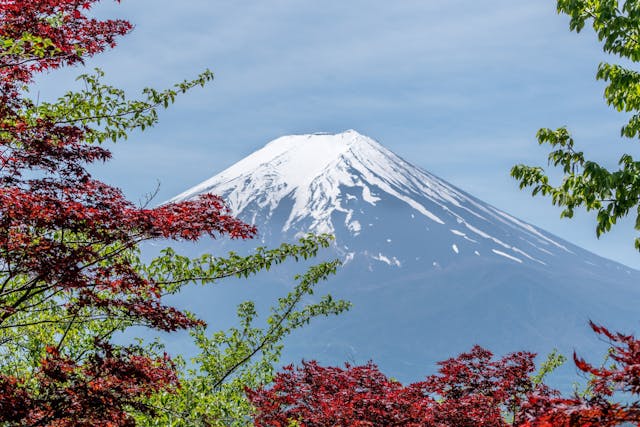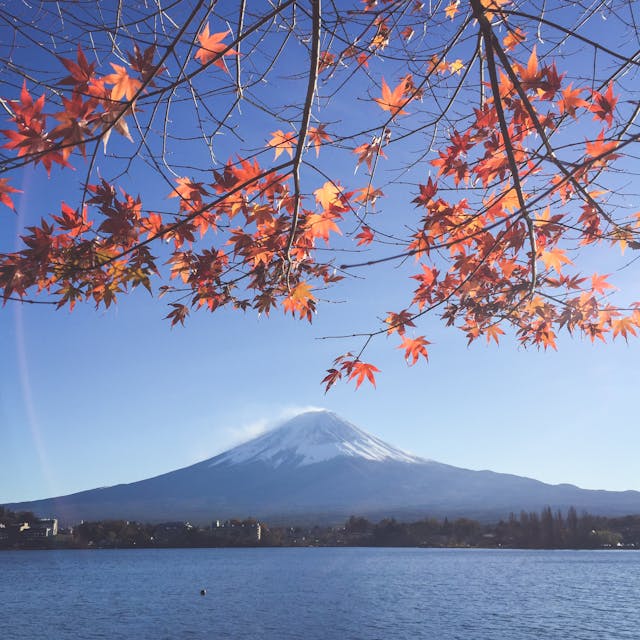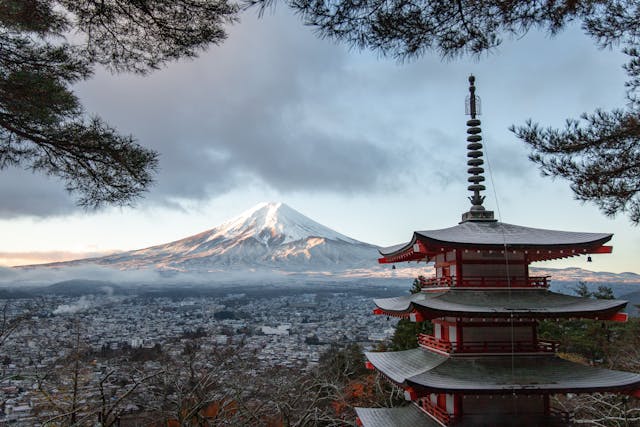GertieBlu e yōkoso, your one-stop travel blog for the curious and adventurous at heart! Today, we’re exploring one of Japan’s most iconic landmarks: Mount Fuji. Whether you’re an avid hiker or someone who simply wants to take in the stunning views, this guide will help you plan the perfect visit. Let’s dive into the best time to visit and how to get there!
Mount Fuji: Japan’s Iconic Peak
Standing at 3,776 meters (12,389 feet), Mount Fuji is the highest peak in Japan and one of the country’s most recognizable symbols. It’s located on Honshu Island, about 100 kilometers (62 miles) southwest of Tokyo, and can be seen from the city on clear days. Fuji-san, as it is lovingly called in Japan, is a UNESCO World Heritage site and a cultural icon that has inspired poets, artists, and travelers for centuries.
Whether you want to climb Mount Fuji, photograph its beauty, or enjoy the surrounding natural parks, this guide will help you find the perfect time to visit and explain how to get there easily.
When Is the Best Time to Visit Mount Fuji?
The best time to visit depends on what you want to do. Here’s a breakdown for hikers and non-hikers:
Best Time for Hiking: July to Early September
If you’re planning to climb Mount Fuji, the official climbing season is July to early September. During these months, the trails are open, mountain huts are available for rest, and weather conditions are most favorable. The summit is often snow-free during this period, making the climb much safer for hikers.
- Weather: Summer temperatures are mild at the base but can be quite chilly at the summit, even in July and August. Expect daytime highs at the summit to hover around 5-10°C (41-50°F).
- Crowds: This is the most popular time to hike, so you’ll find crowds, especially during weekends and holidays. If you prefer fewer people, aim to climb on a weekday in early July or late August.
- Sunrise Views: Many hikers aim to reach the summit before dawn to catch the gorgeous sunrise (known as “Goraiko”). The sight of the sun rising over Japan from the top of Fuji is a spiritual and awe-inspiring experience!
Pro Tip: If you’re not an experienced hiker, consider the popular Yoshida Trail. It’s the most well-maintained and has several rest stops along the way.

Best Time for Sightseeing and Photography: October to April
If you’re not planning to climb Mount Fuji but want to enjoy its beauty, the best time to visit is during autumn and winter when the weather is clearer and the mountain is often capped with snow. October to April is perfect for photography and sightseeing.
- Autumn (October-November): The fall foliage in the surrounding areas, especially around the Fuji Five Lakes and Hakone, adds a stunning contrast to the snow-covered peak.
- Winter (December-February): Winter offers the clearest skies and sharpest views of Mount Fuji. Although it’s cold, the mountain is incredibly picturesque during this time.
- Spring (March-April): Cherry blossoms (sakura) bloom in early April, making it an ideal time for those who want a blend of Japan’s natural beauty — pink blossoms with Mount Fuji in the background.
Pro Tip: For the best views of Mount Fuji without hiking, visit Lake Kawaguchi (one of the Fuji Five Lakes) or the Chureito Pagoda for iconic photo opportunities.
How to Get to Mount Fuji
Mount Fuji’s location makes it easily accessible from major cities like Tokyo and Osaka. Here’s how you can get there:
From Tokyo
There are multiple ways to reach Mount Fuji from Tokyo, whether you’re hiking or just visiting for the day.
- By Train: The fastest way is via the JR Tokaido Shinkansen to Shin-Fuji Station. From there, take a bus to the base of the mountain. If you’re planning to visit the Fuji Five Lakes area, take a direct train from Shinjuku Station on the JR Chuo Line to Otsuki Station, then transfer to the Fujikyu Railway to Kawaguchiko Station. This takes about 2 hours.
- By Bus: If you’re looking for a more affordable option, buses from Shinjuku Expressway Bus Terminal in Tokyo run directly to Kawaguchiko Station, Fuji Subaru Line 5th Station (the starting point for climbers), and other points of interest. Bus rides take approximately 2 to 2.5 hours.
- By Car: Renting a car is also an option if you want more flexibility. The drive from Tokyo to Mount Fuji takes about 2 hours via the Tomei Expressway. This option is ideal for travelers who want to explore the surrounding areas, such as Hakone and the Fuji Five Lakes region.
From Osaka or Kyoto
- By Train: Take the JR Tokaido Shinkansen from Osaka or Kyoto to Mishima Station. From there, you can take a bus to Mount Fuji’s base or the Fuji Five Lakes area. The journey takes around 3.5 hours.
- By Bus: There are also long-distance highway buses from Osaka and Kyoto to the Mount Fuji area, though these are much slower, taking around 8-9 hours. However, if you’re on a budget, this could be a more affordable way to travel.
Pro Tip: If you’re planning to travel extensively around Japan, consider purchasing a JR Pass to save on transportation costs for shinkansen (bullet trains) and other JR lines.

Must-See Spots Around Mount Fuji
Even if you’re not planning to climb Mount Fuji, there are plenty of attractions nearby that are worth visiting:
- Fuji Five Lakes: This area offers stunning views of Mount Fuji reflecting in the waters of the lakes. The most famous of the five lakes is Lake Kawaguchi, which is perfect for photographers.
- Hakone: Known for its hot springs (onsen) and views of Mount Fuji, Hakone is a relaxing stop after a day of sightseeing.
- Chureito Pagoda: For the iconic photo of a pagoda with Mount Fuji in the background, head to Chureito Pagoda, especially during cherry blossom season.
- Gotemba Premium Outlets: If you love shopping, this massive outlet mall near Mount Fuji offers fantastic views of the mountain as you shop for deals.
Final Thoughts
Whether you want to hike to the summit or simply enjoy the magnificent views from afar, Mount Fuji is a must-visit destination for anyone traveling to Japan. The best time to visit depends on your goals — July to early September for hikers, and October to April for those seeking picturesque views. With easy access from Tokyo and other major cities, getting there is simple, whether you prefer trains, buses, or cars.
Planning a trip to Mount Fuji soon? Whether you’re gearing up for a hike or just looking forward to breathtaking views, I hope this guide helps you plan the perfect visit. Stay tuned for more travel tips and inspiration here at GertieBlu!
Happy travels!









